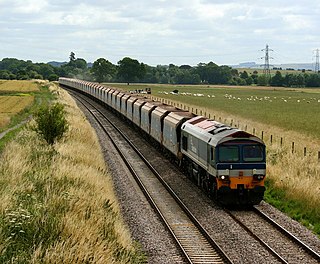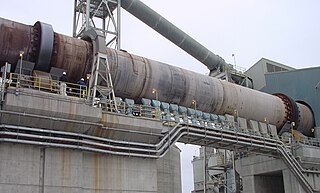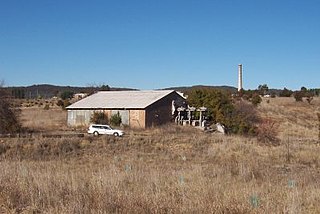
A cement is a binder, a chemical substance used for construction that sets, hardens, and adheres to other materials to bind them together. Cement is seldom used on its own, but rather to bind sand and gravel (aggregate) together. Cement mixed with fine aggregate produces mortar for masonry, or with sand and gravel, produces concrete. Concrete is the most widely used material in existence and is behind only water as the planet's most-consumed resource.

Portland cement is the most common type of cement in general use around the world as a basic ingredient of concrete, mortar, stucco, and non-specialty grout. It was developed from other types of hydraulic lime in England in the early 19th century by Joseph Aspdin, and is usually made from limestone. It is a fine powder, produced by heating limestone and clay minerals in a kiln to form clinker, grinding the clinker, and adding 2 to 3 percent of gypsum. Several types of portland cement are available. The most common, called ordinary portland cement (OPC), is grey, but white portland cement is also available. Its name is derived from its resemblance to portland stone which was quarried on the Isle of Portland in Dorset, England. It was named by Joseph Aspdin who obtained a patent for it in 1824. His son William Aspdin is regarded as the inventor of "modern" portland cement due to his developments in the 1840s. The term portland in this context refers to a material or process, not a proper noun like a place or a person, and should not be capitalized.

A lime kiln is a kiln used for the calcination of limestone (calcium carbonate) to produce the form of lime called quicklime (calcium oxide). The chemical equation for this reaction is

Ketton is a village and civil parish in Rutland in the East Midlands of England. It is about 8 miles (13 km) east of Oakham and 3 miles (5 km) west of Stamford, Lincolnshire. The 2011 Census recorded a parish population of 1,926, making it the fourth largest settlement in Rutland, after Oakham, Uppingham and Cottesmore. The village has a primary school.

ENCI is a Dutch company based in Maastricht, Rotterdam and IJmuiden. Their core business activity consists of the digging of marl out of St Pietersberg, which they use to make cement. The company has been around since 1924, with some key locations being in Maastricht and Sint-Pietersberg. The Maastricht location was closed in 2020.

Mendip Rail Ltd is an independent freight operating railway company in Great Britain. It is a joint venture composed of the rail-operation divisions of Aggregate Industries and Hanson Aggregates.

Bishop's Itchington is a village and civil parish in the Stratford-on-Avon district of Warwickshire, England. It is about 3 miles (5 km) south-southwest of Southam and about 6.5 miles (10 km) southeast of Royal Leamington Spa. The 2011 Census recorded the parish's population as 2,082.

Aberthaw Cement Works are cement works in the Vale of Glamorgan near the village of East Aberthaw in Wales.

Hanson Cement is a cement production company located in the United Kingdom. It was called Castle Cement until it was rebranded in 2009. The company is now owned by HeidelbergCement. Hanson Cement has a long history dating back to the early 19th century, when it was founded as the Portland Cement Company.

Cement kilns are used for the pyroprocessing stage of manufacture of portland and other types of hydraulic cement, in which calcium carbonate reacts with silica-bearing minerals to form a mixture of calcium silicates. Over a billion tonnes of cement are made per year, and cement kilns are the heart of this production process: their capacity usually defines the capacity of the cement plant. As the main energy-consuming and greenhouse-gas–emitting stage of cement manufacture, improvement of kiln efficiency has been the central concern of cement manufacturing technology. Emissions from cement kilns are a major source of greenhouse gas emissions, accounting for around 2.5% of non-natural carbon emissions worldwide.

Cement clinker is a solid material produced in the manufacture of portland cement as an intermediary product. Clinker occurs as lumps or nodules, usually 3 millimetres (0.12 in) to 25 millimetres (0.98 in) in diameter. It is produced by sintering limestone and aluminosilicate materials such as clay during the cement kiln stage.

A raw mill is the equipment used to grind raw materials into "rawmix" during the manufacture of cement. Rawmix is then fed to a cement kiln, which transforms it into clinker, which is then ground to make cement in the cement mill. The raw milling stage of the process effectively defines the chemistry of the finished cement, and has a large effect upon the efficiency of the whole manufacturing process.

Heidelberg Materials is a German multinational building materials company headquartered in Heidelberg, Germany. Formerly known as HeidelbergCement AG, the company has rebranded as Heidelberg Materials in September 2022. It is a DAX corporation and stands as one of the world's largest building materials companies. On 1 July 2016, HeidelbergCement AG completed the acquisition of a 45% shareholding in Italcementi. This acquisition made HeidelbergCement the number one producer of construction aggregates, the second-largest in cement and the third-largest in ready-mixed concrete worldwide. In the 2020 Forbes Global 2000, HeidelbergCement was ranked as the 678th -largest public company in the world.
Shree Cement is an Indian cement manufacturer, founded in Beawar, Rajasthan, in 1979. Now headquartered in Kolkata, it is India's third largest cement producer and second largest cement company by market capitalisation. Shree Cement has moved in the last two decades from having 2 million tonne (mt) production capacity to becoming the country’s third largest cement player, with an installed capacity of 43.3 mt in India and 47.4 mt overseas. It also produces and sells power under the name Shree Power and Shree Mega Power.
Mysore Cements Limited is one of major producers of Cement in south India since its establishment in 1958 – 59 by Karnataka-based industrialist Sarangapani Mudaliar and by collaboration of Kaisers USA as a Public Limited Company The company produced its major output of 1 ton cement with the investment of about 20 million Rupees, in 1962. MCL was immediately taken over by Kaisers and G.D Birla and from then the following years company started producing more cement and it was 4 tpa by the end of year 1968. With an investment of 23 million, MCL produced 6 tpa of cement in Ammasandra unit Based in Tumkur District of Karnataka State. After the death of G.D Birla, in 1983 MCL was totally under control of Birlas and Shri. S.K Birla, grandson of GD Birla was declared the chairman of the organisation.
The south bank of the Humber Estuary in England is a relatively unpopulated area containing large scale industrial development built from the 1950s onward, including national scale petroleum and chemical plants as well as gigawatt scale gas fired power stations.

Thos. W. Ward Ltd was a Sheffield, Yorkshire, steel, engineering and cement business, which began as coal and coke merchants. It expanded into recycling metal for Sheffield's steel industry, and then the supply and manufacture of machinery.

Raffan's Mill and Brick Bottle Kilns is a heritage-listed lime kiln at Carlton Road, Portland, New South Wales, Australia. It was built from 1884 to 1895 by George Raffan and Alexander Currie. It is also known as Raffan's Mill and Brick Bottle Kilns Precinct, Portland Cement Works Site, Williwa Street Portland. The property is owned by Boral. It was added to the New South Wales State Heritage Register on 3 August 2012.
Portland Cement Works Precinct is a heritage-listed former cement works and limestone quarries and now disused industrial site at Williwa Street, Portland, City of Lithgow, New South Wales, Australia. It was designed and built in various stages from 1890 to 2003. It is also known as Portland Cement Group and Commonwealth Portland Cement Company Ltd. The property is owned by Boral Limited. It was added to the New South Wales State Heritage Register on 3 August 2012.

Hope Cement Works, is a cement plant located near to the village of Hope in Derbyshire, England. The plant is mostly self-contained with its own shale and limestone quarries adjacent, with only fuel and small amounts of additives needing to be brought in. The site is located inside the Peak District National Park, and so is subject to tighter planning restrictions than other cement plants in the United Kingdom. It is now the largest cement plant in the United Kingdom, and is also one of the largest emitters of CO2 within the national park.


















